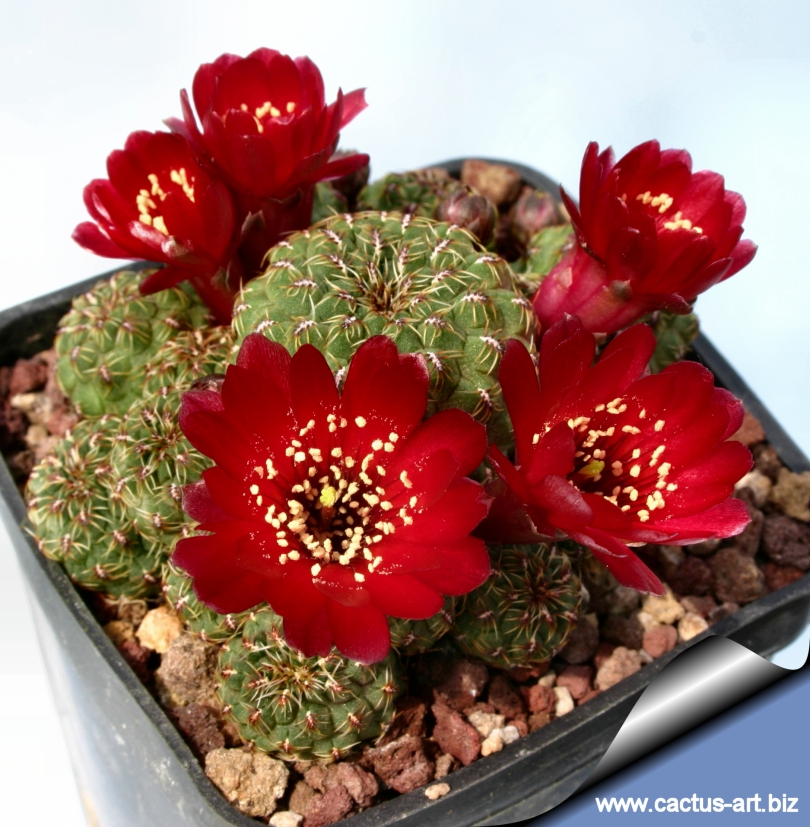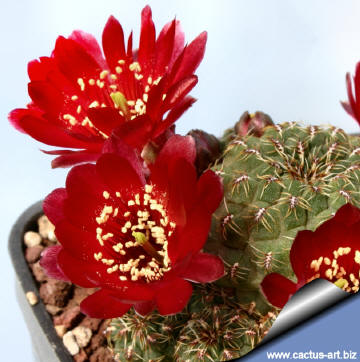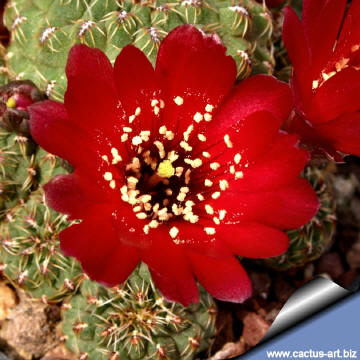|
|
|

Sulcorebutia pasopayana EM 356. Road Presto - Pasopaya, 3200 m, dpt.
Chiquisaca, Bolivia.
It is small headed low growing clumping cactus with lovely dark
red flowers.
|
 |
 |
|


|
|
Advertising
|
|
|
|
|
Family:
Cactaceae (Cactus
Family) Sulcorebutia pasopayana
(F.Brandt) Gertel
in: Kakt. And. Sukk., 42 (7): 176: 1991
Accepted
Scientific Name:
Sulcorebutia canigueralii var.
canigueralli
(Cardenas) Buining & Donald 1965
The species name “pasopayana” ( from
the typical locality of Pasopaya) has been given by Brandt to the
plants with the field number Lau 387.
Distribution: Road Presto - Pasopaya, Zudanez, Chuquisaca,
Bolivia 2700-3200m
Conservation status: Listed in
CITES Appendix II.
Synonyms:
-
Weingartia perplexiflora
Brandt
In: De luetzerburger Cacteefreen,
3: 1, 1982
- Rebutia canigueralii Cárdenas
1964
-
Weingartia canigueralii
(Cardenas) F.H.Brandt 1978
-
Weingartia
pasopayana Brandt,
In: Kakt. Orch. Rundschau, 9: 3, 1984
|
|
|
|
Cultivation:
S. pasopayana loves a very
permeable, coarse
mineral soil as well as to be strictly
kept dry throughout the
winter quiescent period since it is very
sensitive to any
moisture excesses, To prevent
rottenness it is also advisable to surround its
root neck by very rough
sand or
grit, this help a fast water
drainage and an appropriate
air circulation.
For its
sensitive roots this species is frequently
grafted to avoid root problems.
Watering Needs:
Water
moderately in the
growing season, keep
dry during the
winter rest
Frost Tolerance:
Plants are
and quite
frost hardy -5 (-15)° C but prefeably
overwinter in a cool place (at 0/10°C) this is important for the
flowers as well as for plants
health. Without this cool winter period they normally wont get any
buds.
Sun Exposure:
Needs a full
sun exposure ( light shadow my be useful in the hottest summer days)
Propagation: Seed,
cutting,
grafting
|
|
Description: A small-headed
low growing, mound forming, cactus
that forms large clumps, sometime with hundreds of heads . The tiny
spines are held close to the body giving it the canigueralii look. The
flowers are blood red.
Stem: Flattened globose, apex
depressed which, branches profusely from the base. Dull olive-green,
individual stems 20-40 mm in
diameter, 20-30 mm tall.
The stem is covered by flat
tubercles (5mm wide). In older plants tubercles are arranged in up
to 16
spiral line merging in the apex.
Areoles : Long
narrow with
short white
felt.
Radial spines: 8-12
yellow/brown, fine, bristle-like 2-10 mm long.
Pectinated,
±
pointing
diagonally and downward.
Central spines: Usually absent.
Flowers: Very dark magenta or red sometimes with a paler
throats. 3-4 cm long and in diameter.
Floral tube
funnel-shaped yellowish green with tan coloured
scales.
Blooming season: Flowers are produced in late spring and remain
open for three or four days.
Fruit: Dark brownish red.,
4 - 5 mm wide.
|
|
Photo of
conspecific taxa, varieties, forms and cultivars of
plants belonging to the Lobivia
canigueralli complex
(This
Taxon has lots of synonyms whit
several controversial varieties and subspecies and comprises a multitude
of different forms, but where each form is linked to others by
populations of plants with intermediate characteristics):
|
|